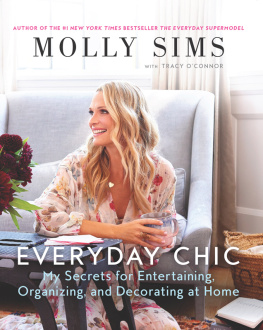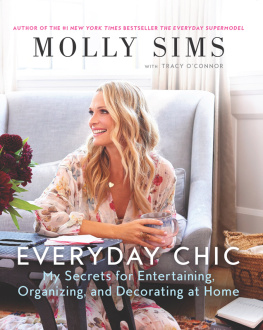I dedicate this book to all the beginners out there.
Keep at it; we all have to start somewhere.
The impetus for writing this book was my manic (and true Cancerian) need to establish a comfortable home upon my arrival in New York City in the fall of 2008. I work from home, so a careless attempt at home just would not do, not with the chaos of big-city life lurking just on the other side of my door.
Im not going to lie to you: most of the things Ive written about here were rather daunting to me at first glance too. This book materialized from coaxing myself into and eventually reconciling with the formerly intimidating task of keeping house (while maintaining some sort of life outside the home).
I didnt learn many of these things growing up, or if I did, I blocked them out entirely. I was surely not a natural born homemaker, or even remotely good at things domestic. My mother swears we sewed together, but thoughts of my grandmas handmade blouses and slacks deeply frightened me at age thirteen, so I conveniently left that skill-sharing session off the mental record. I wasnt bad at cleaning when I was growing up, but those times I mustered up the inspiration to do it were because I was grounded or extremely broke.
As it turns out, moving to Brooklyn served as inspiration in both of the aforesaid capacities. I didnt have much money in hand (still dont) and was sequestered at home (still am), so I had to learn how to make my home a livable one out of necessity. After the house was reasonably settled, I kept going and decided to learn how to incorporate other impressive acts of domesticity into my routine. With a how-hard-can-this-be attitude and a little help from some friends who actually knew what they were doing, I discovered and cultivated a new confidence in myself as I learned these skills. You will too after you learn some of these tasks.
To use this book as a quick decorating-on-the-cheap reference, check out Part I, Room-by-Room Guide to a Homey House, Homie. If youre wanting to read the book as a source for dredging up inspiration for the more housewifey tasks at hand, then Part II, Impressive Acts of Domesticity: Do Try This at Home, is a fun section to peruse. Consult Part III, Life After Restaurants, for a baby-steps introduction to your kitchen and things you might eventually do in there.
Part I provides quick and easy solutions to make your place cozier. These are steps that wont take all day or a weeks pay. Check out these low-cost, creative touches to help you tap into and show off your inner artist.
Part II is the meat and potatoes of home ass-kicking, from attempting your own mending to getting happy life stains off your prized linens and cleaning with stuff you could eat (not that you actually want a baking-soda-and-vinegar cocktail). Every hip homie should get tight with his or her tool kit; after all, its not exactly useful when you dont know how to use it.
Part III is all about impressing yourself (and others) with the gratifying pleasures of kitchen self-sufficiency; this is a first-time guide for the first-time cook, baker, home preserver, and entertainer. Regardless of the size of your kitchen, youll learn how to make your own convenience products and not spend the few dollars you have on things you can do yourself. Most important, youll find out how to show off your hard work by having people over to enjoy your space.
Why Homemaking?
Because its cool to have a cool house. Its damn gratifying to throw down a loaf of homemade bread with your home-preserved blueberry jam. Because feeling in control in your own house does wonders for every instance when youre not under that sweet roof.
This book is for your first forays into householding tasks, both alone and with others, from college through the middle adult years. Its for all the ladies and gents who need a place to relax and rejuvenate; maybe youre single and lovin it, or maybe you (and spouse) fit all the components of the traditional household unit yet your place (or attitude) still feels wan. No matter your station in life, you deserve a charming and inviting place to call home.
So what do you do? Do you entrust this feat to IKEA? Do you ignore it entirely? Do you think it impossible until youve found a significant other? A roommate who does dishes? Heres your guidebook, you the reluctant homemaker, charming individual, to extend the personality I know you have into the home (which I also know you have).
For the record, Ill never assume that all this stuff is easy breezy (when placed in the context of your entire life). I understand that the home feels like the never-ending chorey, and Im a firm believer that sometimes looking the other way is the best solution.
Just remember: the house is supposed to be relaxing, and if its your attitude toward it thats stressing you out, just change your mind. Dont think about the stack of laundry you should put away, the sweeping under the bed that never actually happens, how the plants didnt get watered. You, the house, and likely even the plants will survive. Make a list, and then schedule yourself at home to manage these things under less pressure.
Housekeeping Under Fire
Those old-school homekeeping manuals, though handy, are a bit unwieldy in times of chaos. The only time I consult mine is when somethings gone wrong: Ive dyed all my whites a pretty shade of pink with an insurgent sock, or Ive forgotten for the seven hundredth time on which side of the plate the napkin should be placed. Nowadays the Internet spouts at least ten answers before we can even glance over at the bookshelf, so why another book?
The digital age has its perks, dont get me wrong. But the digital age is uninspiring, to say the least. Sure, I can double-click my way to instructions for just about anything, but rarely do those instructions seek me out. You have to want to do these kinds of things, and you have to know how to ask the questions. Whats more, if a task seems intimidating (as most everything does for any novice), the chance that youll give it a try is slim to none.
I hand you a book, dear reader, so you dont just bookmark these things as ideas to try someday. I think you, O busy one, can swing most of this stuff before the next time you even review your browser bookmarks.
I advocate for strength in numbers, the involvement of real friends (whom you may or may not have found through Facebook or Twitter), and the experience of hands-on knowledge. Youll learn how to throw parties on the fly, share skills or craft parties, and get people in your home for real live ways to show off your domestic accomplishments.
Whose Job is This Anyway?
Busy working women have existed throughout time. My great-grandmother Harriet was a live-in housekeeper and nanny for a wealthy family in Michigan, leaving domestic duties in her own home to the eldest of her eight children. Grandma MannieBertha Burnham, whom youll meet periodically throughout the bookstole warm cookies from the countertop (rather than help bake them) and chased after the boys in the marshland behind their house. She remains anti-domestic.
My great-grandmother Rose, on the other hand, had the time to cook, entertain, and keep house. She baked bread weekly and imparted this (along with many other tools for domestic bliss) to her only daughter, VirginiaGrandma Jinny.
Ill not make this book about gender, because the advice in this book is as much for guys as it is for girls. Lets make this about life in general. Im a girl, so this is obviously from my perspective, but I live with another girl, so whos supposed to do all this stuff around the house?














